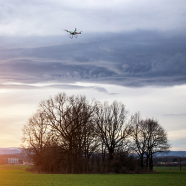Share This
UAV Used To Smuggle Drugs Into Prison
The United States has the largest prison population per capita of any industrialized nation. It should therefore come as no surprise to find that high tech has made its way into that demographic almost as easily as it does outside prison walls. And the most common vehicle for delivering technology into prisons is also now high tech.
Correctional officials in Ohio recently announced that a fight among inmates at the Mansfield Correctional Institution was caused when a UAV was used to drop more than seven ounces of heroin, marijuana, and tobacco into the prison yard. Drone Drops Drugs Into Ohio Prison Yard: The Newest Smuggling Method? While drugs can be delivered into a prison by simply tossing a drug-laden tennis ball or faux rock over the wall, the primary use of UAV’s appears to be Smartphone delivery. Airmail via Drones Is Vexing for Prisons. Smartphones are extremely valuable to inmates because they are not monitored or recorded in prisons and can be used for many unlawful purposes, including coordinating delivery, via UAV, of additional contraband. UAV’s have been discovered attempting to deliver contraband into prisons in the US, Canada, Ireland, Britain, and Australia. Over the past two years, the 10 discovered attempts are viewed as the tip of the iceberg. Officials have no way of knowing how many attempts are successful. Judging by the increasing number of Smartphones found in prisons (one inmate was recently discovered hiding 17 devices in his cell) the number of successes is suspected to be substantial.
DJI, the largest producer of hobby drones suggests Geofencing—programming “no fly” coordinates into UAV flight control software—as the best means to prevent the problem. To that end, the company Noflyzone, Inc. has published a website where property owners can register their address to be added to a comprehensive airspace database provided to UAV companies for inclusion in their “no fly” programming. However, the decreasing cost to build DIY drones and the availability of open source control software, suggests such measures will be a stop-gap at best.




